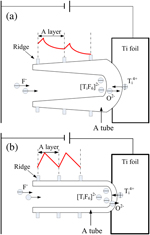Crossref Citations
This article has been cited by the following publications. This list is generated based on data provided by
Crossref.
Sturgeon, Matthew R.
Lai, Peng
and
Hu, Michael Z.
2011.
A comparative study of anodized titania nanotube architectures in aqueous and nonaqueous solutions.
Journal of Materials Research,
Vol. 26,
Issue. 20,
p.
2612.
Guan, Dongsheng
Hymel, Paul J.
and
Wang, Ying
2012.
Growth mechanism and morphology control of double-layer and bamboo-type TiO2 nanotube arrays by anodic oxidation.
Electrochimica Acta,
Vol. 83,
Issue. ,
p.
420.
Ruiquan, Yang
Longfei, Jiang
Xufei, Zhu
Ye, Song
Dongliang, Yu
and
Aijun, Han
2012.
Theoretical derivation of ionic current and electronic current and comparison between fitting curves and measured curves.
RSC Advances,
Vol. 2,
Issue. 32,
p.
12474.
Zhong, Xiao-min
Yu, Dong-liang
Zhang, Shao-yu
Chen, Xi
Song, Ye
Li, Dong-dong
and
Zhu, Xu-fei
2013.
Fabrication and Formation Mechanism of Triple-Layered TiO2Nanotubes.
Journal of The Electrochemical Society,
Vol. 160,
Issue. 10,
p.
E125.
Uhm, Soo-Hyuk
Song, Doo-Hoon
Kwon, Jae-Sung
Im, Su-Yeon
Han, Jeon-Geon
and
Kim, Kyoung-Nam
2013.
Time-dependent growth of TiO2 nanotubes from a magnetron sputtered Ti thin film.
Thin Solid Films,
Vol. 547,
Issue. ,
p.
181.
Chen, Hao-Hong
Lei, Fang
Zhao, Jing-Tai
Shi, Ying
and
Xie, Jian-Jun
2013.
Preparation and photovoltaic properties of N-doped TiO2nanocrystals in vacuum.
Journal of Materials Research,
Vol. 28,
Issue. 3,
p.
468.
Regonini, D.
Bowen, C.R.
Jaroenworaluck, A.
and
Stevens, R.
2013.
A review of growth mechanism, structure and crystallinity of anodized TiO2 nanotubes.
Materials Science and Engineering: R: Reports,
Vol. 74,
Issue. 12,
p.
377.
Lin, Chan
Chen, Shougang
and
Cao, Lixin
2013.
Anodic formation of aligned and bamboo-type TiO2 nanotubes at constant low voltages.
Materials Science in Semiconductor Processing,
Vol. 16,
Issue. 1,
p.
154.
Gui, Qunfang
Yu, Dongliang
Zhang, Shaoyu
Xiao, Huapeng
Yang, Chunyan
Song, Ye
and
Zhu, Xufei
2014.
Influence of anodizing voltage mode on the nanostructure of TiO2 nanotubes.
Journal of Solid State Electrochemistry,
Vol. 18,
Issue. 1,
p.
141.
Sun, B.
Li, Q. L.
Zhao, W. X.
Li, H. W.
Wei, L. J.
and
Chen, P.
2014.
White-light-controlled resistance switching in TiO2/α-Fe2O3 composite nanorods array.
Journal of Nanoparticle Research,
Vol. 16,
Issue. 5,
Sun, Bai
Zhao, Wenxi
Liu, Yonghong
and
Chen, Peng
2014.
White-light-controlled resistive switching and photovoltaic effects in TiO2/ZnO composite nanorods array at room temperature.
Journal of Materials Science: Materials in Electronics,
Vol. 25,
Issue. 10,
p.
4306.
JI, Yajun
2014.
Growth mechanism and photocatalytic performance of double-walled and bamboo-type TiO2nanotube arrays.
RSC Adv.,
Vol. 4,
Issue. 76,
p.
40474.
Gönüllü, Yakup
Kelm, Klemens
Mathur, Sanjay
and
Saruhan, Bilge
2014.
Equivalent Circuit Models for Determination of the Relation between the Sensing Behavior and Properties of Undoped/Cr Doped TiO2 NTs.
Chemosensors,
Vol. 2,
Issue. 1,
p.
69.
Kim, Sunkyu
Seong, Mijeong
and
Choi, Jinsub
2015.
Rapid Breakdown Anodization for the Preparation of Titania Nanotubes in Halogen-Free Acids.
Journal of The Electrochemical Society,
Vol. 162,
Issue. 6,
p.
C205.
Zhang, Yulian
Cheng, Weijie
Du, Fei
Zhang, Shaoyu
Ma, Weihua
Li, Dongdong
Song, Ye
and
Zhu, Xufei
2015.
Quantitative relationship between nanotube length and anodizing current during constant current anodization.
Electrochimica Acta,
Vol. 180,
Issue. ,
p.
147.
Sun, Bai
Liu, Yonghong
Lou, Fangming
and
Chen, Peng
2015.
White-light-controlled resistive switching chearacteristics of TiO 2 /Cu 2 O composite nanorods array.
Chemical Physics,
Vol. 457,
Issue. ,
p.
28.
Zhang, Yulian
Fan, Haowen
Ding, Xu
Yan, Qinghai
Wang, Liping
and
Ma, Weihua
2015.
Simulation of anodizing current-time curves and morphology evolution of TiO2 nanotubes anodized in electrolytes with different NH4F concentrations.
Electrochimica Acta,
Vol. 176,
Issue. ,
p.
1083.
Bhosle, Sachin M.
Tewari, Radheshyam
and
Friedrich, Craig R.
2016.
Dependence of Nanotextured Titanium Orthopedic Surfaces on Electrolyte Condition.
Journal of Surface Engineered Materials and Advanced Technology,
Vol. 06,
Issue. 04,
p.
164.
Cao, Chunbin
Zhang, Guoshun
Ye, Jian
Hua, Rimao
Sun, Zhaoqi
and
Cui, Jingbiao
2016.
Fast growth of self-aligned titania nanotube arrays with excellent transient photoelectric responses.
Electrochimica Acta,
Vol. 211,
Issue. ,
p.
552.
Chen, Shiyi
Chen, Qun
Gao, Mingqi
Yan, Shuo
Jin, Rong
and
Zhu, Xufei
2017.
Morphology evolution of TiO2 nanotubes by a slow anodization in mixed electrolytes.
Surface and Coatings Technology,
Vol. 321,
Issue. ,
p.
257.





